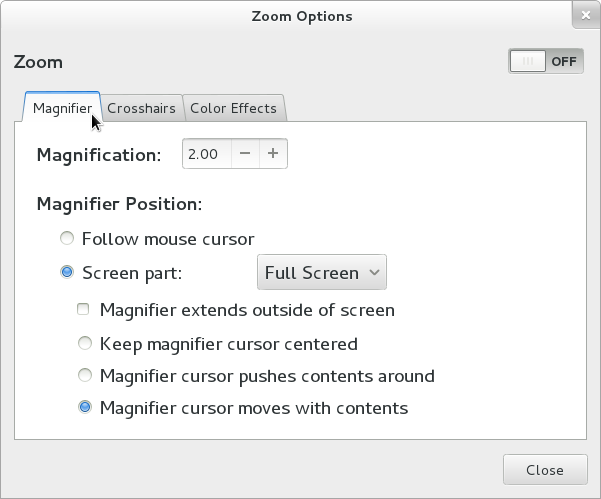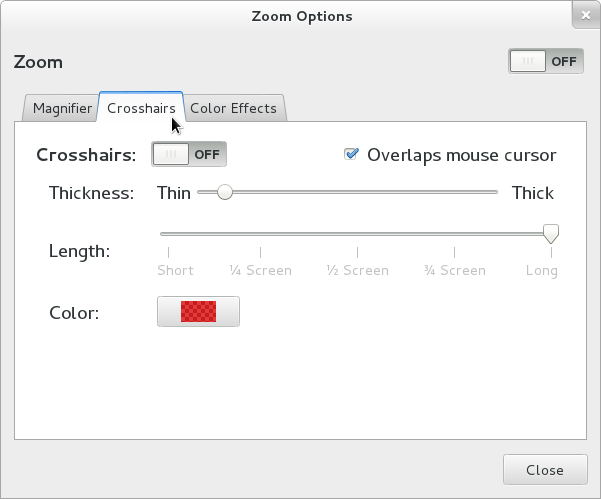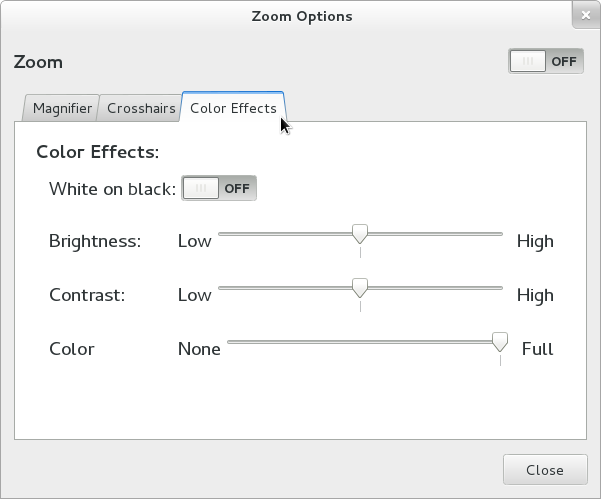Magnification: This page provides magnifier information related to GNOME Accessibility. |
Zoom Options Dialog (Universal Access)
The Zoom Options Dialog (Figure 1) allows users to configure a number of display enhancements. The dialog is divided into three tabs for screen magnification, mouse crosshairs, and colour effects. There is an on/off switch for toggling these enhancements.

Figure 1. Zoom Options Dialog
Magnifier Tab
Figure 1. above shows the "Magnifier" Tab selected.
Magnification
This spinner allows you to set the magnification factor for the screen magnifier. The values are in terms of magnification factor or percentages. For example, a value of 2.00 represents a magnification factor of 2x or 200% magnification. The values range from 1.00 to 20 times.
Magnifier Position
These preferences relate to the position of the magnifier on the desktop, and how its position is affected by mouse movements.
Follow mouse cursor / Screen part
When the Follow mouse cursor radio button is selected, the magnifier is positioned over the mouse pointer, and moves with the mouse. In effect, the magnifier behaves like a lens held over the screen. The size of the lens is determined by the Screen part popup menu.
When the Screen part radio button is selected, the magnifier has a fixed location on the desktop. The location is determined by the popup menu. The options in this popup are:
- Full Screen (default)
- The magnifier occupies the full screen.
- Top Half
- The magnifier occupies the top half of the screen.
- Bottom Half
- The magnifier occupies the bottom half of the screen.
- Left Half
- The magnifier occupies the left half of the screen.
- Right Half
- The magnifier occupies the right half of the screen.
In all cases, as you move the mouse pointer to locations outside of the magnified view, the contents are moved such that the contents near the mouse are visible within the magnifier.
Screen Part sub-section
Magnifier extends outside of screen
When the Magnifier extends outside of screen checkbox is checked, the contents within the magnifier continue to scroll even when the mouse approaches an edge of the desktop. For example, as the mouse approaches the left edge of the desktop, that edge shifts within the magnified view.
When the Magnifier extends outside of screen checkbox is unchecked, as the mouse approaches an edge, the contents cease to scroll, and only the mouse moves.
Mouse Tracking Radio Button Group
This group of radio buttons determine how mouse movements affect the scrolling of content within the magnifier.
- Keep magnifier cursor centered
- The magnified mouse pointer is fixed at the center of the magnifier. The contents are shifted within the magnified view, such that the point under the actual mouse pointer is placed under the magnified mouse cursor image. The visual effect is that the magnified contents scroll under the magnified mouse image as the actual mouse is moved around the screen.
- Magnified cursor pushes contents around
- The magnified contents generally do not move and the magnified mouse moves as the user moves the actual mouse. However, when the magnified pointer pushes against an edge of the magnified view, the magnified contents are scrolled into view. For example, if the user is moving the mouse against the right edge of the magnifier, then the magnified contents are shifted to the left.
- Magnifier cursor moves with contents (default)
- The magnified contents scroll as the mouse is moved. However, the position of the magnified mouse image is not fixed at the center of the magnified view. Instead, its position is representative of where the actual mouse pointer is on the screen. If the actual mouse is in the bottom left quadrant and half way between the center and bottom of the screen, then the magnified cursor image is in the bottom left quadrant and half way towards the bottom of the magnified view. In this way, the position of the magnified mouse cursor within the magnifier provides a clue to the user as to where the real mouse is on the desktop.
Crosshairs Tab
Crosshairs are an option to help locate the mouse. The crosshairs tab is shown in Figure 2.

Figure 2. Zoom Options Dialog showing the "Crosshairs" Tab.
Crosshairs Switch
The switch labelled Crosshairs toggles the display of crosshairs.
Overlaps mouse cursor
When the Overlaps mouse cursor checkbox is checked, the crosshairs intersect the mouse pointer. When unchecked, the crosshairs end before intersecting the mouse cursor.
Thickness
The Thickness slider determines the width of the crosshairs. The range is from 1 to 100 pixels.
Length
The Length slider determines the length of the crosshairs. The range is from very short, through fractions of the size of the screen, to a length that extends to the edges of the screen.
Color
The color button launches a color chooser dialog to set the color and transparency of the crosshairs.
Color Effects Tab
Color effects include inverse video, brightness, contrast, and grayscale options for users with photophobia or for using the computer under adverse lighting conditions. The effects tab is shown in Figure 3.

Figure 3. Zoom Options Dialog showing the "Color Effects" Tab.
White on black Switch
The switch labelled White on black toggles a lightness inversion effect. When in the on position, white becomes black, and black, white. Also, darker colors and grays become lighter, while lighter colors and grays become darker. The hue of a color does not change, e.g., the predominantly orange FireFox icon remains orange after inversion.
Brightness
The Brightness slider affects the overall brightness of the view. Its default position is the center of the slider, representing the standard out-of-the-box setting. Moving the thumb towards the High end of the slider increases overall brightness. Moving towards the Low end decreases it.
Note: if White on black is toggled on, then the effects of the Brightness slider are reversed.
Contrast
The Contrast slider affects the overall contrast of the view. Its default position is the center of the slider, representing standard contrast. Moving the thumb towards the High end of the slider increases overall contrast. Moving towards the Low end decreases it.
Color
The Color slider determines saturation of the colors. The range is from None to Full, where full color is the default setting. When positioned at None, the view is fully gray scale. Positions in between provide varying degress of color.
Zoom Options Dialog is part of the ÆGIS (Ontario) Project. It is funded and supported by the Ontario Ministry of Economic Development and Innovation and the ÆGIS (Europe) Project.

